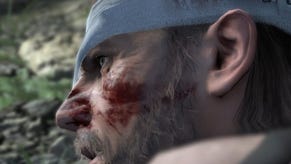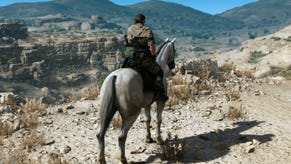Digital Foundry: Hands-on with Metal Gear Solid 5
Can Xbox One's 900p upgrade sustain 60fps? And how does it compare with PS4?
If you're still on the fence, it's fair to say Metal Gear Solid 5: The Phantom Pain is a worthwhile purchase on both PlayStation 4 and Xbox One. In particular, the Xbox One version is much improved over last year's Ground Zeroes - this time offering a native 1600x900 resolution that gives the console a huge leap over the last game's disappointing 720p setup. But how well does this measure up to PS4's full 1080p - and indeed, does the resolution boost take its toll in terms of raw performance?
Despite the ambiguous phrasing of Konami's official platform comparison, where it lists Xbox One as "900p (final output 1080p)", the turnout is actually quite straightforward. Microsoft's console is set to render at a fixed 1600x900 throughout, backed by all the signs of a post-process FXAA. Meanwhile, PS4 offers the same anti-aliasing method to clean up jagged edges, albeit with a much crisper 1920x1080 resolution as its starting point.
This works out very well for Xbox One. The 56 per cent increase in resolution over Ground Zeroes means the game's broad vistas can be seen through a clearer window - and even trees and buildings far off into the distance appear closer to PS4's level of clarity. Sony's platform wins out in direct comparisons of course, having no need to upscale its image. However, it must be said Xbox One acquits itself very nicely at 900p, and despite some softening to foliage elements, its resolution is no longer a tangible limiting factor to the experience.
We'll be reporting back with a more in-depth Face-Off feature soon - but it's fair to say the comparison between PS4 and Xbox One is otherwise quite simple. Just as with Ground Zeroes, world geometry, textures, and effects are all identical based on our playthroughs so far. Shadow resolution relies on the same method too, with a light dithering to the edges of each patch of shade - and ambient occlusion is an absolute match as well (right down to the curious banding artefacts we see around characters in the open).
Just one minor point to address before we go on. Currently, Xbox One has a 1.01 patch available, while PlayStation 4 does not. Conceivably, further improvements may arrive. But what we can say is that the performance pressure points highlighted later on in this article show no difference on Xbox One, whether we're running straight from the retail disc or with the 1.01 patch in place.


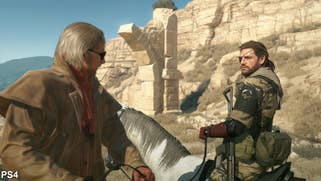

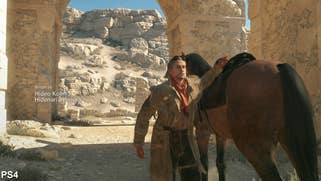


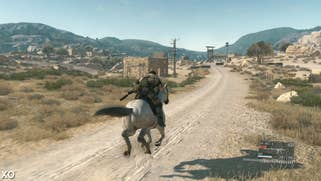



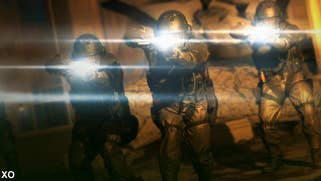
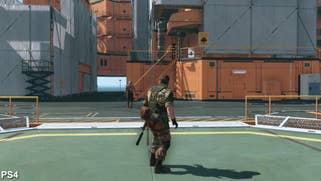
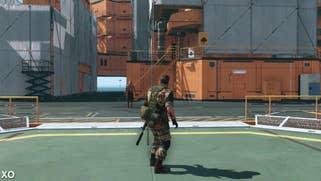
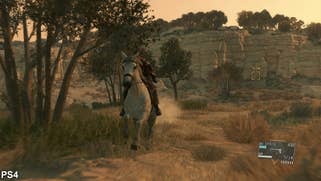
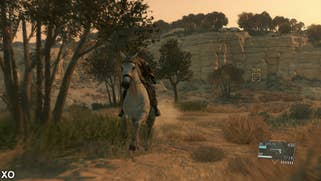
Pop-in is a minor issue on each (as with Ground Zeroes), and the threshold for shadow and geometry draw is like-for-like between PS4 and Xbox One. In fact, the only real difference we see is in the handling of texture filtering. Both use a low-grade method that heavily blurs the ground at oblique angles, but PS4 at least offers a slightly superior range. As Snake walks forward, this essentially amounts to an extra half-step of clear texturing, before its detail is muddied to Xbox One's standard. This is a point that goes unnoticed outside of side-by-side comparisons though - and neither really has much to boast about.
But with the resolution gap narrowed to 900p versus 1080p, Xbox One at least holds its own in the visual comparison. The Fox Engine hasn't flattered Microsoft's flagship platform prior to The Phantom Pain - with even Pro Evolution Soccer 2015 delivering a jagged, 1280x720 native picture. However, it's a relief to see this low pixel-count is confined to just this, and the Ground Zeroes prologue. At 900p, there's a sense that optimisations have been made and we're moving forward.
But one question remains: has Xbox One's jump to 900p affected performance? After all, Ground Zeroes ran at an impeccable 60fps with nary a drop on either platform, and to see frame-rate performance sacrificed for resolution would be something of a side-step. Fortunately, this doesn't appear the case at all, and having tested Xbox One across the first ten missions, this 60fps target is still met with strong conviction.
To keep things spoiler-free, we're abiding by the rules set by Konami on video content - we'll publish a full video analysis at the game's launch. For now, screen-grabs of our analysis are just as revealing. We thought we'd try a different format this time, and give you a snapshot of the game's performance profile on both PS4 and Xbox One across a range of scenes.
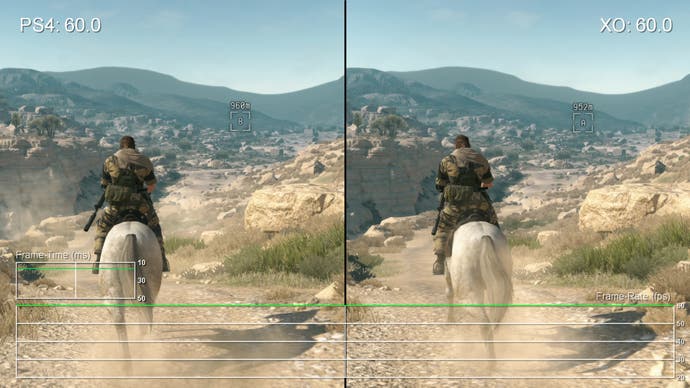
First up, the basics. In gameplay, both PS4 and Xbox One run at a near-flawless 60fps, with v-sync engaged at all times to avoid tearing. The heightened pixel count on Xbox One doesn't appear to hamper this, even when faced with a valley filled with foliage elements. Travelling at speed across busy terrain gives us 60fps as well - an impressive feat, especially given the broader world scale since Ground Zeroes.

Pushing the Fox Engine with heavy alpha doesn't interrupt this 60fps line. Even when faced with eight or more enemies, plus exploding barrels, there's no straying from the top-most target on PS4 or Xbox One.

Accepting 60fps as the norm, there are sporadic, one-off dips on both platforms. Here we see PS4 slipping a frame as we draw close to a target location. The cause isn't entirely clear, as the renderer provably handles more intensive scenes at a perfect 60fps - though PS4 and Xbox One are equally prone to this light hiccupping.

A later shot of a dropped frame on Xbox One. This kicks in just as we land a few bullets while in a slow motion state - cueing the use of chromatic aberration and motion blur towards the screen's edges. The impact on controller response is negligible, and again, we see far more complex areas run without any such stuttering at all.

Almost every cut-scene in The Phantom Pain holds a solid 60fps, but on the rare occasion that they do drop, it's a hard downward lurch. In these cases, a double-buffered v-sync locks PS4 to the 30fps line, and Xbox One tends to better maintain its composure at around 50fps. It's worth pointing out that actual drops like this are exceptional but as a stress-test, it does show how PS4 and Xbox One cope when faced with extreme engine load. It also makes it apparent that Xbox One's memory bandwidth is not, as might have been the case, being bottlenecked by the push to 1600x900 - a resource also tapped into by the alpha effects shown here. Surprisingly, Xbox One is capable of riding out these stress-points at a higher performance level than PS4.

This performance divide is consistent with later stress-points too - as seen above, though once again, we should stress that these moments are fleeting and very rare indeed. Character close-ups like this show PS4 simply locking to 30fps, while Xbox One once again rides the scene out at 48fps. The jury's out on why this is precisely the case; this area runs at a perfect 60fps until the camera hones in on his glasses' reflections. Bizarrely, texture mapping (note across his forehead) also struggles to stream in on PS4 at this point - though other scenes show no problem. [Update 28/8/15 11:30am: on re-testing this scene, texture streaming can safely be ruled out as the cause. Instead, skin shading methods between PS4 and Xbox One differ for extreme close-ups such as this - and we can confirm this is the case for other close-ups in this vein, giving shadows and dimples across faces on PS4 a subtler, blended look. The suggestion is this is an approximated form of subsurface scattering that works in favour of PS4 at these moments - a point we intend to cross-check with other platforms.]
Overall, the Xbox One release of The Phantom Pain is a closer match for PS4 thanks to its bump to 1600x900, and at seemingly no sacrifice to performance. After a disappointing technical turnout with Ground Zeroes last year, image quality is now very respectable on Xbox One, despite the upscale. It's shy of PS4's full 1080p image in terms of absolute clarity, but the results still flatter the game's big ambition.
And pleasingly, 60fps isn't in jeopardy for either release. Despite the anomalous stress-points above, frame-rate purists will be pleased with Kojima's fifth main entry in the Metal Gear Solid line - provided you stick to current-gen consoles. The Phantom Pain is a very taxing game, and in terms of the Xbox 360 and PlayStation 3, the older hardware is pushed right to its limits and sometimes the experience can feel rather strained. We're playing both of these versions in tandem right now and aim to bring you first impressions as soon as we can.







